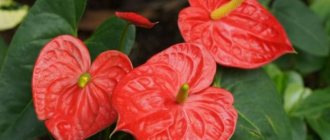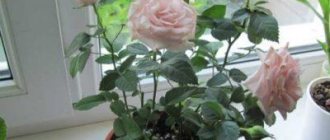A tiny rose in a flower pot is the dream of many house plant lovers. The delicate aroma of flowers and the grace of the branches will not leave anyone indifferent. But it is believed that growing indoor roses is very difficult.
How difficult is it to care for a miniature house rose? It is no more difficult than caring for an ordinary garden one, if you provide it with the same conditions. The rose is not a tropical plant or a desert flower; it requires a temperate climate and cool wintering.
Indoor rose (genus rose, or wild rose (Rosa)), belongs to the Rose family (Rosaceae). Potted roses are compact bushes up to 35-45 cm. Currently, several hundred varieties of miniature roses have been bred, and the assortment is constantly being replenished. They are conventionally divided into groups Mini-Flora, Miniature and Polyantha.
The flowers of indoor roses are small, very decorative, can be fragrant or odorless, and come in a variety of colors.
Caring for indoor roses varies depending on the season. As in natural conditions, it requires a cold winter. Too high a temperature in summer is also harmful. In the warm season, these plants are recommended to be taken out into the open air.
Flowering miniature rose bushes are also available for sale in winter. It is very beautiful, but after the flowering period a dormant period is required to allow the plant to rest. And in this case, the dormant period shifts to spring - the time when in nature plants wake up and develop. Lack of such rest can lead to the death of the rose.
Rose patio mix: care at home
This plant is quite whimsical and demanding. There are situations when a rose, having found itself in new conditions, begins to wither, lose flowers and buds, turn yellow, and dry out. It is often susceptible to pest attacks. In order for the flower to live long and please the owner with a beautiful and healthy appearance, rose owners must follow the recommendations for caring for it.
Caring for a patio rose at home involves providing the plant with the correct regime of watering, lighting, fertilizing and replanting.
What kind of plant is this?
Botanical description
Rose mix belongs to the Rosaceae or Rosehip family . This variety was bred by breeders specifically for growing at home.
Peculiarities
The plant is a small shrub up to 65 centimeters high.
The size and color of the buds depend on the type of flower. As a rule, this is a miniature rose endowed with a delicate aroma. This variety of roses can bloom several times a year. At the same time, the flowers on the plant retain their color and aroma for a long time.
Description and characteristics
Having figured out what a patio rose is, it will be interesting to learn about its appearance and features.
This type of rose looks like a small lush bush with a lot of flowers. These bushes are planted both in open ground and in separate pots, which allows you to keep them at home and decorate rooms, balconies, loggias, and verandas with them. The height of the plant is 40-50 cm. The flowers are from 2 to 5 cm in diameter.
A nice feature of the patio rose is that flowering can last for quite a long time. This is facilitated by pruning the plant.
The variety of varieties is impressive. The term "patio mix rose" is often used to describe this rose. The word “mix” in this case means great variability in the appearance of the plant. Another name used for some varieties is patio hit mix rose. There are at least 2000 varieties of this plant. The colors include all kinds of shades of red and pink, yellow, white, lilac, and color combinations.
As breeders continue to work on developing new varieties of patio rose, we can expect the most unusual shades to appear in the future.
Types and varieties of domestic roses
Cordes roses description and best varieties
Although girls mainly prefer red roses with long stems, blooming beauties in pots are not limited to one color and size. In fact, there are a lot of varieties, they all have not only different bud colors, but also differences in size and care needs.
Miniature
- Dwarf roses got their name because of their miniature height from 5 to 30 (45) cm.
- The root system of such roses spreads, although not low, but very widely.
- Such plants are characterized by dense foliage, while the buds consist of inflorescences of 3-15 small roses. The color range of such plants is quite diverse.
The most popular varieties of miniature roses include: “Easter Morning”, “Fire Princess” and “Hummingbird”.
Hybrid tea
This rose was obtained by crossing remontant and tea varieties. Different varieties have differences in the color of the buds and the size of the stems, but these flowers are united by a strong and bright aroma. The most famous varieties include Lucky Peace, Prima Ballerina and Alexander.
Repairers
This rose is characterized by dense dark green foliage and a long peduncle, shaped like a glass. Although such a rose does not have many flowers, the buds are distinguished by a beauty similar to that very familiar red rose.
Chinese rose (hibiscus)
The Chinese rose differs significantly from its predecessors in both flower shape and leaves. The flower buds during flowering reach from 8 to 14 cm in diameter and externally resemble small cups with a pestle inside. But, unfortunately, this color only lasts 2-3 days.
Rose of Jericho (Anastatika, Jericho)
It is difficult to call such a houseplant a rose, since neither Jericho nor Anastatica resembles an ordinary representative of rose bushes.
Both plants look more like poisonous green corals. The color of the plant is inconspicuous and is expressed by the appearance of small pale white flowers, from which pods with seeds are subsequently formed.
Rosa Cordana
The stem of this flower does not exceed 30 cm, and the flowers are very similar to the classic rose. The blossoming buds please for quite a long time - for six months. The peculiarity of this flower is the complete absence of odor.
Ground cover
This variety belongs to the artisanal variety, and the growth of the plant (as well as the flowering bud and leaves) can be different. Flowers can have from five to 30 petals, while the open bud usually does not exceed 5 cm in diameter. Such a rose can grow at home only with support due to its sufficient height.
Bengal
A bush of this variety is small and quite compact. Flowers of different varieties differ both in shape and size, as well as in color (this species has a fairly rich palette). Although flowering lasts quite a long time, the smell of the plant is almost imperceptible.
The most interesting and popular varieties of Bengal roses include Baby Masquerade and Green Ice.
Roses Patio
The bushes grow from 45 to 55 centimeters in height. The plant has many inflorescences of 3-10 buds with different colors. The main feature of such varieties is the change of inflorescence over and over again, throughout the entire flowering season.
Roses Mix
Rose Mix is several unique varieties that look good at home. These include the Patio Mix rose, the Mini Mix rose and the Cardana Mix. This type of plant is characterized by a stem up to 40 cm high, with single buds that look like a classic rose.
Star Roses
The flower stem reaches 30-35 centimeters with single buds. The main feature of the variety is the shape of the flower, since the outwardly open bud resembles a mixture of peony and rose due to its multiple petals.
Other types
In fact, there are many more types of roses than you might imagine. The fauna includes more than 1,000 species and at least 10,000 varieties of these flowers. For example, Nifeto and Roses roses were not mentioned in the list of the most popular ones.
Varieties of indoor plants
- Korsnoda
The bush is compact, maximum size is 60 cm in height. The flowers are double, white and cream in color. Flowering is long and abundant.
- Rose spray Macarena
The bush is compact, the inflorescences are large. The foliage is glossy. The blooming flowers are rosette-shaped and light yellow in color with a brighter center. Over time they acquire a pink tint.
- Pink Flash
Winter-hardy species. Bush 50-60 cm high. Feature: marble color. The flowers are pink in color; the petals have light pink stripes, which change color to a richer pink in the cold.
Use in landscape design
- Typhoon
Bush up to 70 cm. The flowers are small, the color is red with shades of orange. More often grown in pots than in open ground.
- Patio hit
The bushes are compact, 30-40 cm in height. The flowers are semi-double or double, lush, of different colors.
Rose Patio Hit, which is easy to care for at home, is perhaps the most popular variety of Patio in Russia. Moreover, both experienced flower lovers and beginners are trying to grow it.
Variety of plant varieties
Since the number of varieties is too large to describe them all, this article will discuss only a few popular types of roses.
"Baby Baccarat" The height of the bush is 40-45 cm. There are few thorns on the stems. The flowers with velvety petals are bright red in color and emit a light, delicate aroma. The leaves are dark green and shiny.
"Korsnoda." These roses grow up to half a meter in height. They bloom very profusely, so they are suitable for creating flower arrangements. The petals bend down after the bud has fully opened. It is interesting to note: the number and arrangement of flowers resembles spray, so the word “spray” is used to name such varieties. The flowers are small and gracefully shaped. This variety is actively used to decorate borders in gardens.
"Lydia." This bush can reach a height of 80 cm. It blooms profusely, like the “korsnoda”. Flower diameter up to 4 cm.
"Mimi Eden." A very beautiful variety of patio rose, characterized by two-color petals. White color on the outside, pink in the core. The bush is small, no more than 50 cm in height. There can be up to ten flowers on a branch.
"Red Macarena". Also a representative of spray rose. Low bush up to 50 cm in height. The flowers have a beautiful dark red color and a velvety (terry) texture.
Soil and pot
For homemade rose Mix you need special soil, which can be bought at a flower shop. To make your own substrate, mix turf soil with peat and sand in a 2:2:1 ratio. But be sure to disinfect the mixture before planting. Otherwise, the plant will suffer from pathogenic microbes living in the soil. Before the event, add some granular fertilizer to the mix.
Magnolia: Planting, growing and care in open ground (based on my own experience)
Rose Mix takes root better in ceramic pots with a glazed surface. Their dimensions should exceed the volume of the roots by no more than 2–3 cm. And the pots should also have drainage holes. Before the event, it is advisable to soak such containers in warm water for 2 hours. Then the material will be saturated with moisture and will not then draw water out of the soil.
Selection of location and conditions of detention
Of course, roses love a lighted and well-ventilated location. But what to do if there is only one window sill at home, where in this case you can place the rose and how to properly care for it in order to achieve flowering and growth of the bush, all this is described below.
Lighting and location
You need to place the pot with the Mix variety in a brightly lit place, but you must protect it from direct rays. If the plant does not have enough light, it will stretch upward, while the stems will be thin and practically without leaves. You can compensate for the lack of lighting with a fluorescent lamp; this is a prerequisite during the growth period of the plant.
In order for the crown of the plant to develop normally, the flower must be periodically turned in different directions towards the light. In summer, such a rose can be taken out to the balcony and placed on its windowsill.
Temperature
In warm weather, the optimal indicator will be 25 degrees, and in winter you need to make sure that the temperature does not fall below 15 degrees. Pots with roses should be placed away from heating appliances so that the air around them does not become too dry. It is necessary to ventilate the room more often, take the plant out onto the balcony or veranda. The plant does not tolerate drafts, so it should be protected from them.
Air
Humidity must be maintained at the proper level, especially during the adaptation period and the time of bud formation. If you do not constantly spray the plant, its leaves will turn yellow. It is also possible to spray the buds, but not with a large amount of water. Spraying should not be carried out in the sun, otherwise burns will appear on the leaves; it is best to carry out this procedure in the morning.
Soil and pot
The Mix rose is difficult to grow on your own, so it appears in the house from the store. When they bring her home, they give her time to adapt. Minimum 1 week, but knowing that for abundant flowering when industrially growing plants, special additives are added to them, which is why you should not delay replanting it. You need to choose a pot 2-3 cm larger than the previous one.
The soil must be prepared from turf soil and humus, taken in 4 parts each and 1 part sand is added to them. When the plant is planted in the ground, it is necessary to add fertilizer in granules.
For those who do not want to take risks, it is better to buy ready-made soil mixture.
Roses need to be treated more carefully than all other indoor flowers; without proper attention, they can dry out and it will be impossible to revive them.
Watering
All types of “Mix” love regular irrigation; the soil in the pot should not dry out. Watering should be carried out only with settled water; in winter, watering should be done less often.
Top dressing
After transplantation, fertilizing can be done 30 days later. It can be a solution of mullein or a ready-made mineral mixture; for the leaves of indoor roses, a special liquid fertilizer is used. Fertilizing is carried out after watering, preferably in the evening.
Loosening, mulching
Every time the next day after watering, the top layer of soil in the pot needs to be loosened. An ordinary fork is suitable for these purposes; after this process, the root system of the plant will be able to receive oxygen in sufficient quantities.
Pinching, pinching, pruning
Some types of miniature roses do not need pruning; Mini Mix is one of these exceptions. For those plants that need crown formation, the process is carried out in spring or autumn.
Select a sharp tool; it is better to buy a pruner designed for small diameter branches. First, dried and diseased stems are cut off, and then those that grow deep in the bush are eliminated.
Transfer
After purchasing the Mix rose, it is not necessary to replant it immediately; it is advisable to wait 10 days. Then the procedure for transplanting it from a store pot to a previously prepared one is as follows:
- The pot with the plant is tilted slightly and all sides are tapped.
- Gently pull the stems, while trying not to damage the horse system; if it is not pulled out, then you need to slightly loosen the soil near the pot.
- You can shake off the excess soil a little, but you cannot completely free the roots from the soil.
- Expanded clay is first poured into a new pot to create a drainage layer, and then it is filled with half-prepared soil and a depression is made in it.
- Place the bush right in the middle of the container and cover it on all sides with the rest of the earth. In this case, you should compact the mixture on all sides of the bush, and then water it a little or spray the leaves.
What to do after purchase?
Before sale, the Mix rose is placed in a peat substrate. This soil retains moisture for a long time, which reduces the need to care for the plant in the store. But such soil is not suitable for long-term cultivation. Therefore, after purchase, it is important to replant the crop.
Start the event when the rose has acclimatized to your conditions. Typically this takes 10–12 days. At this time, water the flower regularly, preventing the soil from drying out. And don’t forget to spray the foliage periodically.
Erinnerung an Brod
The spreading bush of this rose can reach 2.5 m in height and 2 m in width. Double flowers of purple-lilac color (up to 8 cm in diameter) exude a rich, pleasant aroma. They can be either single or collected in lush inflorescences of up to 8 pieces.
Many varieties of roses with purple flower colors were bred based on this variety. But this is not all the advantages of Erinnerung an Brod.
These roses often bloom repeatedly, and in regions with warm climates they can delight with beautiful blooms even in winter. Plus, under cover, a bush of such a climbing rose can withstand temperatures of –35°C.
Popular articles When to prune roses for the winter - basic rules
| Purpose | Plant height | Bloom | Aroma | Winter hardiness |
| 250 cm | Abundant, repetitive | Saturated, sweet | Average, shelter required |
Climbing roses are beautiful in their own right, and they also make excellent camouflage for unsightly posts, fences and buildings. Plant them in your dacha - and your plot will sparkle with bright colors.
Transfer
To make the plant take root easier and faster, cut off all the buds without pity before the event. Don't worry, after a while the culture will release new ones. Transplant a miniature rose in this way:
- At the bottom of the container, place a centimeter layer of drainage consisting of pebbles, brick chips or expanded clay. Sprinkle it with a small layer of soil.
- Carefully remove the rose from the pot without destroying the earthen ball.
- Place the flower in a new container and fill the voids with soil. To compact the soil, lightly tap the sides of the pot.
- Spray the foliage with warm water, but do not water the flower.
- After transplanting, place the crop in a shaded area.
- The next day, water the soil and move the pot to a permanent place.
A similar event will need to be carried out in the spring, as the home rose Mix grows.
Diamond Eyes
Flowers with a velvety petal texture, dark purple in color with a white center. Terry, small. The variety is aromatic, rich, spicy. Blooms profusely all season. The bush is low, spherical. The rose is resistant to diseases and tolerates cold well.
History of appearance
The appearance of this plant was preceded by a number of discoveries in the field of breeding. In the second half of the 20th century, floribunda roses were developed. They differed in that the buds and flowers were collected in clusters. Among the floribunda roses, a group of dwarf roses stood out, but at that time they did not have a separate name. It was not until 1980 that a name for this group was proposed. The word "patio" in Spanish means an internal courtyard of a living space, fenced on all sides. Patios are usually small, cozy and beautifully decorated with flowers. It was this word that gave the name to a new type of flower. Photos of patio roses are posted later in the article.
Floribunda roses
These profusely blooming roses are the result of crossing dwarf polyantha roses with hybrid tea roses. Their flowering is not only abundant, but also long-lasting (from July to late autumn), continuous. Flowers can be either simple or double. They are quite large (the shape and size are similar to hybrid tea roses) and are collected in inflorescences. The height of the bush can vary from 30 to 100 cm.
Floribunda roses are characterized by increased winter hardiness and disease resistance.
Varieties and hybrids: Iceberg, Galaxy, Diadem, Georgette, Zorina, Carte Blanche, Lily Marlene, Nicolo Paganini, Nicole, Sangria, Frisia, Shocking Blue.
In the floribunda group, there are low-growing roses called patio (also known as mini-floribunda, or mini-flora). They do not exceed 50 cm in height and are most often grown in containers or in the foreground of borders.
Subvarieties and their photos
Parade
Low plant (40 – 45 cm). Pleases with lush flowering for 5 - 6 months. Then follows a two-month break. Best adapted to home conditions.
Patio hit
The rose belongs to the floribunda group . The stem length is 50 – 55 cm. Large flowers can be of different shades, they even have two-color petals. Blooms long and profusely.
Mini
Dwarf plants (up to 40 cm). The buds can be either small or large in size.
Danica
A small plant about 30 cm high. The size of the petals in a bud is approximately 3 - 5 cm. Their color may vary.
Conditions for wintering
Garden roses of the Patio variety are moved indoors for the winter. Although they can be left to overwinter in the garden. In this case, the bushes are covered with spruce branches. A wire frame is built around the plant, which is covered with film on top. From mid-spring, such a structure should be opened for ventilation. The insulation is removed in the presence of established warm weather.
When moving a rose indoors for the winter, it should be additionally illuminated with fluorescent lamps. The room temperature should be at +20 degrees. If these conditions are not met, then the flower will go into hibernation. For shallow sleep you need a temperature of +15 degrees, and for deep sleep +5 degrees.
The Patio variety rose will be an excellent purchase for both the garden and the home. Minimal care of the bushes will allow the plants to bloom long and abundantly.
Humidity and flower watering regime
Rose requires high humidity. Therefore, caring for a patio rose involves daily spraying the leaves of the plant with water at room temperature. The water should be clean and not cold. It's a good idea to place a humidifier in the room.
Patio roses need to be watered regularly. You can usually navigate by the soil in the pot: if it is dry, the plant needs to be watered. It is advisable to drain excess water from the pan to avoid rotting of the root system.
Preparation of soil and planting material
Many gardeners prefer the miniature Patio rose largely because this plant is unpretentious, and it also takes root well, despite the conditions. The crop can be planted and grown in special containers, in pots on windowsills, or in open ground. Before planting begins, high-quality preparatory work must be carried out. So, preparation consists of two key points, namely:
- choosing the appropriate variety and seedlings of the Patio rose.
- choosing a site for planting.
Large daisy flowers name. Large perennial garden chamomile: how to choose and grow in the garden
After the planting material has been purchased, the seedlings must be washed under warm water to eliminate possible bacteria and microbes. If you plan to plant at home, it is recommended to transfer the seedlings to a large container and then send them to the greenhouse until the optimal time for planting arrives.
Rose Patio actively grows and develops in those areas that are sufficiently illuminated by sunlight, since only the sun can provide bright and abundant flowering. When planted in open ground, seedlings must adapt, so they must be temporarily protected from direct sunlight.
Features of planting and caring for crops in open ground
On a note! To decorate their garden plots, many summer residents plant the Patio rose, which adds a certain “zest” with its lush flowering. The right time for planting crops in open ground is the first half of spring, because the soil should warm up well.
As for the step-by-step landing algorithm, it looks like this:
- In the prepared bed, which needs to be dug up in advance, planting holes should be dug, and the distance between them should be at least 30 cm (each contact of the bushes entails the loss of petals and foliage). The depth of the hole should be 45-50 cm, because the root system of the plant needs a lot of space;
- The bottom of each planting hole must be filled with drainage, which can be gravel, coarse river sand or small stone;
- The next stage is fertilization with humus or any other organic matter, after which the holes are covered with a small layer of earth;
- After the seedlings have been placed in the planting holes, they need to be sprinkled with soil and compacted a little. Before you start watering the Patio rose, you need to dig small holes.
Important! If, when purchasing seedlings, it is discovered that they have an open root system, they must be kept in water for several hours before planting in open ground. Seedlings with closed roots are planted together with a lump of earth.
Features of caring for crops in open ground
Temperature
The capricious rose Mix does not tolerate both heat and cold. In summer, the optimal temperature for the crop is +20…+23 °C. In winter, temperatures should not drop below +15 °C. For normal development, the flower needs fresh air. Therefore, ventilate the room in which you grow your rose more often. In summer, move the pot to the balcony or garden. But choose places protected from the wind with diffused light.
At any time of the year, protect the flower from drafts, and when ventilating the room, take the pot to another room. And also do not grow indoor roses near radiators or heating devices. If this is not possible, then build a screen of foil or cardboard between the pot and the heat sources.
How to organize a rose garden on your property step by step
To ensure that the flowers in the flowerbed do not lose their beauty, the area must be properly decorated. Organizing the process step by step will save time and money. In the early stages, you can predict the slightest problems, so you should not abandon the sequence of measures.
Rose on a high trunkSource domvpavlino.ru
Flower garden along the fenceSource pinterest.com
Place
For a rose garden in a dacha, you need an area that is as open as possible for viewing. Choose a place in the garden, near the main entrance or in a recreation area. If you hide expensive varieties and a complex structure in a remote corner, then the owners will not be able to enjoy a pleasant view.
An abundance of roses of rich cream color Source botanichka.ru
A capricious flower will not throw out buds if there is a lack of sun. Lack of rays negatively affects the shade intensity, size and health of crops. The bushes are drawn towards the light source and deform unsightly. For roses in landscape design, proximity to thick trees and high fences is contraindicated.
Support for roses in a flower bedSource nashgazon.com
Plants feel uncomfortable near the walls of buildings, especially on the western and northern sides. Unprotected from the bright sun, a rose garden in a dacha withers and burns within a few days. The ideal option for the location of the structure is 4 hours of lighting before and after lunch. Gardeners recommend a southern, windless slope.
The soil
Roses in landscape design develop in an area with fertile soil. Wetlands and options with close groundwater are not suitable. The flower lives without problems in light loam, which has an acidity of pH 5-6 units. Before planting plants in the soil, they dig it up, add fertilizers (organic or mineral), and leave it for 90 days to settle.
Tall arch of pink climbing rosesSource kmgram.com
Plan
If you think about the structure of the rose garden at your dacha in advance, then there will be no problems when planting. Decorative structures and flowers along the paths should not interfere with the movement of people. The parameters of the site and the distance to the nearest structures are noted on paper. The drawing will also help you choose the shades of plants and find optimal neighbors.
Popular articles Features of growing Vodyanaya violets
Frame with benches for climbing roses Source ooo-metallist.su
There are two types of layouts for roses in landscape design:
- Embossed. Clear boundaries and correct geometric shapes are observed, complex compositions and solo plantings are used. All elements are interconnected and emphasize the beauty of all plants.
- Landscape. The rose garden at the dacha looks like a natural extension of nature. Suitable for small areas.
Style
When decorating a flower garden, always adhere to style. For the ceremonial direction, bright buds and contrasting combinations are chosen. The entrance or path in white and red looks impressive. Yellow-orange roses in landscape design give the space a solemn sound.
Variety of roses in the flower gardenSource studiofmp.com
The romantic style prefers classic varieties and shades and does not like sharp transitions. Pastel colors and gradients from delicate purple to white dominate here. To decorate a flower garden, choose a secluded area or a place that is significant to the owner.
Yellow roses for a bright rose garden in the countrysideSource weibo.comAccommodation requirements
Patio rose prefers cool temperatures and does not tolerate heat and stuffiness. Therefore, in summer it can be placed on the balcony or veranda. This plant loves light, but it is strictly undesirable to allow it to be exposed to direct sunlight. Leaves may get burned, begin to turn yellow and fall off.
Drafts are no less dangerous for her. If the rose is kept on a window, then in cool and cold weather it is necessary to insulate the windows so that the plant does not freeze. It is better to place the rose on a southwest or southeast window.
During months when daylight hours are short, a fluorescent lamp can be used to provide the desired level of illumination.
How a rose from the Patio variety blooms
Roses blooming is always an event. Dwarf roses have their own characteristics during this period.
Rose Patio is distinguished by long, abundant flowering - sometimes until frost. During flowering, flowers appear both singly and in inflorescences.
For roses, a dormant period is important so that the plant can rest and recover. At this time, the leaves begin to turn yellow and growth slows down. If the plant is in a pot, it needs to be placed in a cooler place.
Important! When kept in a heated apartment on a windowsill, a period of rest cannot be arranged. The only way out is a glass balcony
To prevent the soil from freezing, the pots are placed in boxes with sawdust.
The buds of the Patio rose are similar to those of the hybrid tea rose, which is considered the mother plant in this chain.
There are three types of flowers:
- simple;
- terry;
- semi-double.
Important! In some species, flowers become flat towards the end of flowering. The flowers are lush, maximum diameter is 9 cm, have a pleasant aroma
The flowers are lush, maximum diameter is 9 cm, and have a pleasant aroma.
Roses blooming on the site
Lighting
Rosa Mix is a light-loving plant. But the beauty is harmed by direct rays of the sun, so it is better to grow it near an eastern or western window. On the northern windowsill, the crop will not have enough light, and it will drop its buds and foliage. If you grow a flower near a south window, be sure to shade the foliage during the midday hours. Otherwise, the plant will get burned, which will affect its health and decorativeness.
Baby Baccara
The flowers are medium-sized, juicy red, densely double. The plant itself reaches no more than half a meter in height. An excellent solution for flower beds, container plantings and decorating the edges of lawns, paths, and flower beds.
Growing problems, diseases and pests
What diseases can attack roses?
- powdery mildew;
- rust;
- rot;
- leaf spotting.
Pests may appear:
- spider mite;
- aphid;
- leaf roller
For prevention in the spring, the plant is treated with fungicides or a solution of copper sulfate.
Diseased or infected plants are treated with special preparations: Fitoverm, Karbofos, Hom, Topaz. It is also possible to treat with wood ash or horsetail decoction.
Patio roses are not dwarf varieties, but with their miniature beauty they can decorate any garden as a reward for regular care. Flowers look especially beautiful on the windowsill, surprising random witnesses. Caring for the Patio is not too difficult, so lovers of indoor and garden plants should definitely pay attention to this variety.
How to buy seedlings correctly?
When purchasing, you should pay attention to the appearance of the plant itself. There should be no black dots on the stems. The leaves should adhere firmly to the stems, be elastic and glossy.
Faded leaves are the cause of overheating of the crop, a whitish coating is a sign of spider mite damage to the plant, and brown spots indicate the presence of a fungal infection.
You should also check the plant for pests.
The packaging must be of high quality. It requires information about the variety of rose and the color of the flowers.
Trimming
If you want to get compact and lush bushes of the domestic rose Mix, then you cannot do without formative and sanitary pruning. At the end of winter - beginning of spring, remove all weak, tangled and damaged shoots. Leave 4-5 strong branches on the bush, each with 3-5 “eyes”. Make sure the middle remains free.
In summer, be sure to remove faded buds. They take away strength from the plant, and also look unattractive. Trim the buds from 3-4 cm of the stem. In autumn, shorten the branches, leaving 3-4 buds on each shoot.
Reproduction technique
Representatives of the Patio variety can be propagated in two ways:
- cuttings;
- by grafting a shoot onto a rose hip.
Both methods are quite popular, but cuttings are still used more often. They can be cut from the mother bush at any time. However, branches cut at the beginning of summer take root best. The cut shoot should have a bud, flower, bud or stem.
The cuttings take root in moist and loose soil. Before planting, you can put it in water until roots appear.
Rest period
During the cold season, the rose enters a so-called dormant period. Flowering ends and some of the leaves fall off. During this period, it is advisable to provide the patio rose with a comfortable winter. To do this you will need:
- Transfer the plant to a cool room, preferably with a temperature no higher than +15 degrees.
- Reduce watering, spraying and fertilizing.
- Be sure to trim the plant, shortening the length of the branches by about a third.
If you correctly follow all the recommendations for maintaining and caring for a patio rose, including instructions regarding wintering, then in the spring the plant will delight the owner with rapid growth and the appearance of a large number of buds.
Care
Caring for patio roses is easy, both at home and in the garden. How to care in the garden and at home?
Location
It is recommended to grow the crop in a bright place, be it a window, balcony or open ground. In garden areas, direct sunlight is not dangerous for roses. However, if it has been growing at home for a long time, then before moving the plant into the garden, the flower will need adaptation to the rays of the sun. This also applies to newly purchased flowers.
To prevent sunburn at midday, when the sun is too bright, it is advisable to protect the plant from the rays. To prevent the root system from being damaged by overheating, the pot can be placed in a large, light-colored pot, or wrapped in white paper.
It is necessary to regularly ventilate the room. In a dark place, the patio rose will develop poorly and slowly, and may also refuse to bloom.
Watering and humidity
Watering the crop is required regularly. It should be moderate. It is not recommended to allow the soil to dry completely between waterings; only a slight drying of the top layer of soil is allowed.
Stagnant water is also dangerous for roses . It can lead to rotting of the root system, so you should not overwater the plant. In addition, a drainage layer is needed in the soil or at the bottom of the pot.
Spraying is allowed, but not in direct sunlight. This procedure will help you endure the heat and heat. However, excessive spraying can lead to the development of fungus.
Important! For irrigation, it is recommended to use only warm and settled water.
Feeding
Fertilizing must be done throughout the spring and summer season. They are also allowed in winter, but only if there is additional lighting.
Special fertilizers for roses are used as fertilizing. These can be purchased at flower shops. It is better to fertilize frequently, but in small portions. This will improve absorption and prevent oversaturation of the soil.
It is not recommended to start feeding the plant immediately after purchase. It is better to start fertilizing after 3 months. This is due to the fact that the roses sold are already well enriched with special long-acting fertilizers. And additional application will cause soil salinization.
Wintering in the garden and indoors
For the winter, some dig up the plant and move it indoors for the winter, while others leave the patio rose to overwinter in the garden. At the same time, it needs to be covered with spruce branches. A wire frame is placed around the bush, which should be several centimeters higher than the bush itself. Polyethylene material and film are placed on it. Starting from mid-spring, the plants need to be ventilated, and soon the insulation is completely removed.
Since in winter the rose often lacks natural light, the use of artificial lighting lamps is recommended. In this case, the air temperature should be about 20 degrees. However, if such conditions cannot be ensured, then the plant can be sent to winter. Wintering can be deep or shallow.
For shallow sleep, the plant needs to provide a temperature no higher than 15 degrees. And for deep sleep, the temperature is lowered to 5 degrees. However, it is necessary to lower the temperature gradually. In deep sleep, the rose sheds its leaves, and the lack of light no longer frightens it.
Pests
The plant is often affected by spider mites. It can be detected by a whitish coating in the form of a cobweb on the leaves. It must be combated with the help of insecticidal agents (Aktara, Aktellik, Fitoverm and others).











